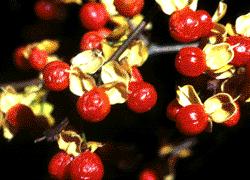
Known As: American Bittersweet, Bittersweet, Climbing Bittersweet,
Climbing Orange-root, Climbing Staff Tree, False Bittersweet, Fevertwig,
Fever-twitch, Jacob's Ladder, Roxbury Waxwork, Shrubby Bittersweet, Staff
Tree, Staff Vine, Waxwork, Yellowroot
Latin Name: Celastraceae family
Description: Attractive trailing vine that climbs any surface.
Fine textured, glossy-green leaves cover the stem. When a young plant
the clinging stems have small leaves but established plants may have mature
bushy branches with inconspicuous small greenish flowers, bright red berries
and larger, leathery leaves. Flowers have 5 sepals, petals and stamens
with a fleshy disk between stamens and pistil. Some variants may
also have white-edged leaves. Some family members are grown as ornamentals,
particularly members of the genus Euonymus, a diverse group of trees, shrubs,
and woody climbers, some of which produce brilliant autumn colors, such
as Burning Bush or Wahoo, E. atropurpurea.
Poisonous parts: Bark, leaves and seeds. Berries
can be fatal.
Symptoms: Vomiting, abdominal cramps, diarrhea, convulsions,
coma..
Treatment: Unless your cat is unconscious or having convulsions,
induce vomiting and follow procedures to delay
absorption and speed elimination. Get prompt veterinary assistance.

Other common names.—False bittersweet, climbing bittersweet, shrubby
bittersweet,
fevertwig, fever-twitch, staff tree, climbing staff tree, staff vine,
waxwork, Roxbury waxwork,
yellowroot, climbing orange-root, Jacob's-ladder.
Habitat and range.—This woody vine or climbing shrub is found in woods
and thickets,
growing in rich damp soil from Ontario to Manitoba and south to North
Carolina and New
Mexico.
Description.—American bittersweet is a woody and shrubby climber, growing
over trees or
fences. It has smooth thin leaves 2 to 4 inches long and about half
as wide. The small
greenish-white or greenish-yellow flowers are produced in June in short
clusters. The fruit is a
roundish, orange-yellow capsule which opens in autumn, disclosing the
scarlet-colored seed.
The seed capsules remain on the plant well into the cold season.
A decorative vine with light green leaves and massive amounts of scarlet
berries.

